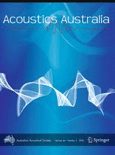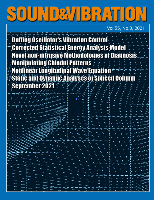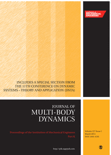
International Journal of Acoustics and Vibration
Scope & Guideline
Exploring the Sound of Innovation in Acoustics and Vibration
Introduction
Aims and Scopes
- Acoustic Modeling and Analysis:
The journal publishes research on acoustic modeling techniques and analyses that address various applications, including sound absorption, noise control, and acoustic comfort in different environments. - Vibration Analysis and Control:
This area covers the study of vibration dynamics in mechanical systems, including methods for vibration reduction and control strategies for enhancing system performance. - Structural Health Monitoring and Diagnostics:
Research on non-destructive testing methods, diagnostics, and damage assessment techniques for structures using vibration and acoustic signals is a significant focus. - Metamaterials and Advanced Materials:
The journal explores the development and optimization of advanced materials, including metamaterials, for applications in sound and vibration manipulation. - Numerical Simulation and Experimental Validation:
A strong emphasis is placed on the integration of numerical simulations with experimental validations to enhance the reliability of findings in acoustics and vibration research. - Innovative Computational Techniques:
The use of machine learning, deep learning, and other advanced computational methods to analyze and predict acoustic and vibrational phenomena is a growing area of interest.
Trending and Emerging
- Machine Learning and AI in Acoustics and Vibration:
The integration of machine learning and artificial intelligence techniques for fault diagnosis, anomaly detection, and predictive maintenance in mechanical systems is gaining momentum, showcasing the potential for improved accuracy and efficiency. - Vibration Control in Autonomous Systems:
Research on vibration control strategies for autonomous systems, including drones and underwater vehicles, is emerging as a critical area, emphasizing the need for enhanced stability and performance in dynamic environments. - Sustainability and Environmental Noise Management:
There is an increasing focus on sustainable practices in acoustics, particularly in reducing environmental noise and improving soundscapes in urban settings, reflecting societal concerns regarding noise pollution. - Advanced Materials for Acoustic Applications:
The study of innovative materials, such as metamaterials and piezoelectric materials, for enhancing acoustic performance and vibration control is trending, highlighting a shift towards materials science in acoustics. - Interdisciplinary Research in Acoustics and Vibration:
The journal is witnessing a rise in interdisciplinary studies that combine acoustics with fields like robotics, transportation, and environmental science, reflecting the broad applicability of acoustic and vibrational principles.
Declining or Waning
- Traditional Acoustic Measurement Techniques:
There has been a noticeable decrease in papers focused solely on conventional acoustic measurement techniques as researchers increasingly adopt advanced computational methods and technologies. - Generalized Theoretical Studies:
The prevalence of purely theoretical studies without practical applications has declined, as the journal increasingly favors research with tangible real-world implications. - Acoustic Studies in Non-Mechanical Systems:
Research focusing on acoustic phenomena in non-mechanical systems has become less prominent, possibly due to a growing emphasis on mechanical and structural applications.
Similar Journals

Acoustics Australia
Advancing Sound Science for a Better TomorrowAcoustics Australia is a prominent journal dedicated to advancing research and knowledge in the fields of acoustics and ultrasonics. Published by Springer Singapore Pte Ltd, this esteemed journal holds a Q2 ranking in the 2023 Scopus categories, reflecting its significant impact and reputation within the academic community, particularly evidenced by its position in the 67th percentile among its peers. Since its inception, with publication converging in years from 1986 to 1991 and again from 1996 to 2024, Acoustics Australia has been a vital platform for scholars to publish innovative research, share findings, and foster collaboration among professionals dedicated to the science of sound. Although not an Open Access journal, it remains an essential resource for researchers, academics, and students alike, providing insights that drive advancements in technology, environmental science, and health-related applications linked to acoustics.

SOUND AND VIBRATION
Innovative Insights into Acoustics and Engineering PrinciplesSOUND AND VIBRATION, published by TECH SCIENCE PRESS, is a pivotal journal in the fields of Acoustics and Ultrasonics, Mechanical Engineering, and Safety, Risk, Reliability, and Quality. With an ISSN of 1541-0161, this journal has been a reliable source of innovative research and developments from its inception in 1976 through to 2024. Although it currently ranks in the Q4 category on Scopus, it serves as a vital platform for the dissemination of studies focusing on sound and vibration phenomena, contributing to the understanding and advancement of engineering principles. Researchers and professionals are encouraged to utilize this journal to gain insights into critical acoustic applications and mechanical dynamics. While SOUND AND VIBRATION does not operate under an Open Access model, it remains a valuable asset for anyone committed to exploring the various ramifications of sound and vibration in engineering and applied sciences.

Mechanical Sciences
Illuminating the future of mechanical engineering and beyond.Mechanical Sciences is a prominent open-access journal published by COPERNICUS GESELLSCHAFT MBH since 2010, dedicated to advancing the field of mechanical engineering and its multidisciplinary applications. Operating from Göttingen, Germany, the journal has established a vital platform for researchers and professionals alike, facilitating the sharing of original research, reviews, and innovative methodologies across various domains, including civil and structural engineering, control and systems engineering, fluid flow, industrial engineering, and mechanics of materials. With a current impact factor placing it in the Q3 category across several engineering disciplines, Mechanical Sciences provides a valuable resource that not only highlights emerging trends but also contributes to the ongoing discourse within the engineering community. The journal's commitment to open access ensures that its content is widely accessible, encouraging collaboration and knowledge sharing among students, educators, and industry experts worldwide. As it continues to converge towards 2024, Mechanical Sciences remains an essential reference for anyone invested in the mechanics of engineering and related fields.

JOURNAL OF VIBRATION AND ACOUSTICS-TRANSACTIONS OF THE ASME
Fostering Dialogue in Vibrational and Acoustic ResearchThe JOURNAL OF VIBRATION AND ACOUSTICS-TRANSACTIONS OF THE ASME is a leading publication in the field of vibration and acoustics, committed to advancing knowledge and understanding in these vital areas of mechanical engineering. Published by the esteemed American Society of Mechanical Engineers (ASME), this journal has a strong presence in both the academic and professional communities, evidenced by its impressive Scopus rankings, which place it in the top quartiles of Acoustics and Ultrasonics (Q1), Mechanical Engineering (Q2), and Mechanics of Materials (Q2) as of 2023. The journal features original research articles, technical papers, and case studies that offer breakthrough insights and innovative methodologies, fostering a rich dialogue among scholars, researchers, and industry professionals. With its convergence of knowledge spanning from 1983 to 2024, it remains a crucial resource for those looking to stay at the forefront of research in vibration and acoustics. Although not currently open access, its rigorous peer-review process ensures high-quality content that is essential for practitioners and researchers alike.

ARCHIVES OF MECHANICS
Exploring New Dimensions in Mechanics Since 1971Archives of Mechanics, published by the Polish Academy of Sciences Institute of Fundamental Technological Research, is a distinguished open-access journal established in 1971 that has played a pivotal role in the dissemination of knowledge in the fields of Mechanical Engineering and Condensed Matter Physics. With its commitment to accessibility since adopting open access in 2022, this journal provides a platform for researchers, professionals, and students to share cutting-edge research findings and innovative methodologies. Although it currently holds a Q4 ranking in Condensed Matter Physics and a Q3 ranking in Mechanical Engineering for 2023, its comprehensive scope, which spans critical advancements in mechanical systems and materials science, positions it as a valuable resource for the academic community. Located in Warsaw, Poland, the journal continues to contribute significantly to the global discourse on mechanics and is dedicated to fostering new ideas that advance both theoretical and applied aspects of the discipline.

Acoustics
Sound Science Unleashed: Your Open Access Journal for AcousticsAcoustics is a dynamic, peer-reviewed open access journal published by MDPI, dedicated to advancing the field of acoustics since its inception in 2019. With an E-ISSN of 2624-599X, this journal serves as a pivotal platform for researchers, professionals, and students engaged in the study of sound, its generation, transmission, and reception, as well as its applications across various domains, such as engineering, environmental science, and health. Based in Switzerland, Acoustics has quickly established its reputation, achieving a commendable Q2 ranking in the Acoustics and Ultrasonics category, as well as a noteworthy 16th position out of 44 in Scopus ranking, placing it in the 64th percentile among its peers. The journal aims to provide a comprehensive understanding of acoustic phenomena through interdisciplinary collaborations and innovative research, while ensuring immediate and free access to all published articles. For those vested in the ever-evolving landscape of acoustics, this journal represents a crucial resource for the latest developments and findings in the field.

Journal of Vibration Engineering & Technologies
Exploring Innovations in Acoustics and MechanicsJournal of Vibration Engineering & Technologies, published by Springer Heidelberg in Switzerland, is a premier open-access journal dedicated to the expansive field of vibration engineering, focusing on both acoustics and mechanical engineering. With its ISSN 2523-3920 and E-ISSN 2523-3939, the journal has gained significant recognition, achieving a prestigious Q2 ranking in both Acoustics and Ultrasonics and Mechanical Engineering in the 2023 category quartiles. In just a decade since its inception in 2014, it has established a solid foothold in the academic community, as indicated by its Scopus ranks, placing it among the top journals in acoustics (Rank #17/44, 62nd percentile) and in mechanical engineering (Rank #269/672, 60th percentile). The journal aims to disseminate cutting-edge research that advances the understanding and applications of vibration technologies, fostering dialogue among researchers, educators, and industry professionals. As an essential resource for those in academia and industry alike, the Journal of Vibration Engineering & Technologies invites contributions that challenge existing paradigms and propel innovation in the field.

JASA Express Letters
Exploring new horizons in acoustic phenomena and artistic expression.JASA Express Letters is a distinguished open-access journal published by AIP Publishing, dedicated to fostering rapid dissemination of high-quality research in the field of acoustics and related areas of music and arts. With an E-ISSN of 2691-1191, this journal strives to provide a platform for innovative and impactful studies, showcasing research that bridges disciplines and advances our understanding of acoustic phenomena. Since transitioning to open access in 2021, the journal has gained a reputation for swift publication, accommodating the needs of researchers eager to share their findings with a global audience. Notably, JASA Express Letters ranks in the top quartile for music and arts-related disciplines, standing at Rank #25/180 and Rank #174/552 respectively, reflecting its significance and influence within the academic community. This journal serves not only as a valuable resource for scholars and practitioners but also aims to inspire new directions in both theoretical and applied research, enhancing collaborative efforts in the vibrant fields of acoustics and the arts.

Coupled Systems Mechanics
Advancing the Frontiers of Coupled System MechanicsCoupled Systems Mechanics is a pioneering journal in the fields of Civil and Structural Engineering and Mechanics of Materials, published by TECHNO-PRESS. With an ISSN of 2234-2184 and an E-ISSN of 2234-2192, this journal actively contributes to the academic discourse surrounding coupled system mechanics, addressing complex interactions within engineering disciplines. Hailing from South Korea, the journal has been committed to disseminating high-quality research since its inception, converging years from 2017 to 2024. It holds a respectable Q3 ranking in both Civil and Structural Engineering and Mechanics of Materials, indicating its relevance and impact within these fields. Researchers, professionals, and students can expect cutting-edge studies and innovative methodologies, as the journal consistently aims to enhance understanding and application of coupled systems in engineering. Although it operates under a subscription model, it remains an essential resource for those looking to stay at the forefront of advancements in engineering sciences.

PROCEEDINGS OF THE INSTITUTION OF MECHANICAL ENGINEERS PART K-JOURNAL OF MULTI-BODY DYNAMICS
Fostering Knowledge Exchange in Engineering DisciplinesPROCEEDINGS OF THE INSTITUTION OF MECHANICAL ENGINEERS PART K-JOURNAL OF MULTI-BODY DYNAMICS, published by SAGE PUBLICATIONS LTD, stands as a pivotal platform for research dissemination in the fields of Mechanical Engineering and Condensed Matter Physics. With an ISSN of 1464-4193 and an E-ISSN of 2041-3068, this journal covers a broad spectrum of topics related to multi-body dynamics, aiming to facilitate the exchange of knowledge among researchers, professionals, and students alike. With its impressive ranking in the Q2 category for both Mechanical Engineering and Condensed Matter Physics, the journal is recognized for its quality and relevance, placing it within the top 64th and 58th percentiles of its respective fields according to Scopus rankings. Housed in the United Kingdom and accessible via various academic platforms, this journal operates without an open access policy, ensuring rigor in the peer-review process. By bridging theoretical understanding and practical applications, the journal continues to contribute significantly to advancements in multi-body dynamics, making it an essential resource for those engaged in cutting-edge engineering research.